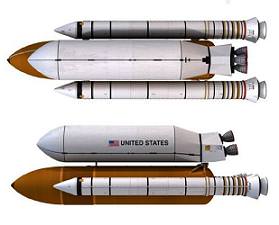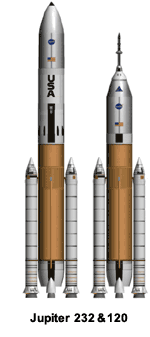[/caption]
NASA Administrator Charlie Bolden has asked for an evaluation of alternative heavy lift rockets, including DIRECT’s Jupiter launch vehicle. The evaluation is a “top priority,” according to NASASpaceflight.com, and a special team from the Marshall Space Flight Center has been commissioned to conduct the study, with the directive to have a report ready by the end of November. Looking at alternatives to the Constellation program is an apparent reaction to the final Augustine Commission report, which will be made public on Thursday.

The other heavy lift vehicle also to be looked at is the Shuttle Derived Heavy Lift Launch Vehicle, which is a shuttle-based concept with a cargo carrier side mounted to the current design of the external tank. The concept is capable of launching 80mt (metric tons) into Low Earth Orbit (LEO) and around 54mt to the moon.
However sources at NASASpaceflight.com note that the DIRECT team’s Jupiter launch system has dominated early discussions at the Special Team meetings.
Bolden also recently hinted that commercial space companies could play a crucial role in NASA’s future. “Some of the most exciting companies in America today go by the names of SpaceX, Blue Origin, Armadillo Aerospace, Virgin Galactic, Xcor, Bigelow Aerospace, Masten, Flag Suit, and Ad Astra,” Bolden said in a speech at the National Association of Investment Companies. “Today, we at NASA are devising ways to work with these companies and others who will come. I urge you, and all other investors, to take notice. Space may someday soon become the new thing in investing.”
For more information on the Direct project, see our previous in-depth article here, or the DirectLauncher website.
Source: NASASpaceflight.com


It would be a huge sign of the maturity of commercial launch capability if the US relied upon commercial vehicles for launch. We don’t have a national airline; do we need a national launch capability?
We do have a national air carrier in the US, it’s called the Air Force.
Go DIRECT!
I favor the SD-HLV because its the cheapest and the fastest to heavy lift vehicle to develop.
But whatever heavy lift vehicle is chosen, their must be enough money left in the budget to also seriously fund the development of the Altair lunar lander starting in 2010 or 2011. It doesn’t make much sense to develop a heavy lift vehicle to return to the Moon if we don’t have the lander ready to place humans and habitat modules on the lunar surface.
“Space may someday soon become the new thing in investing”
Great – just what we need. Greedy businessmen looking for return on investment in the space game. Tell me that won’t arse everything up quicker than you can blink.
The recoverable main engine compartment on the Shuttle Derived Heavy Lift Launch Vehicle is an interesting concept… SME’s aren’t cheap!
I like the idea that existing infrastructure would be used… crumbling flame trenches aside.
I like the idea that we already have experienced shuttle technicians/personel.
A heavy lift vehicle would probably be most useful without manned missions tying it down. Large space telescopes, cosmic sensors, solar system probes and the rest could be lofted with this.
LC
The first stage of the Saturn V was intended to be reused, but after a fall from a hundred thousand feet and the dunking of hot parts in a salt bath… Making the machinery reliable again would have cost more than ditching it. Its not as simple in design as todays SRBs.
That being its own issue:
I think our definition of “heavy” has been on too much of a diet when medium launch systems can contend for it by way of strap on boosters. If “Heavy Lift” cant contend with saturns or even put Obamas rover on the moon, there’s a problem…
If we aren’t going to the moon then its fine. But why spend most of the moon ship money and most of the moon program time to develop a vehicle which barely replaces the shuttle?
If the end problem is still cost then lets throw in on an RLV or some actual launch alternatives. Lets break out of this impossible pricing model that’s made space exploration too expensive to even attempt anymore.
Right now it seems like we’re in a hurry to change contractors when the only thing we can be sure of is getting the same rocket problems in a lesser configuration.
That makes no sense.
Try this for more images, and info. http://www.scribd.com/doc/18029055/NASA-ShuttleC-Heavy-Lift-Launch-Vehicle-2009
I think Jupiter models look pretty sexy, especially compared to the Shuttle derived one. However, I really think they ought to have a jack of all trades type rocket that can do everything “within reason” we want it to do.
ie. a manned mission to moon or mars, even if its not on the books for the near future, at least you wouldn’t have to redevelope a new launch system for future projects.
Astro Friend,
I don’t know. As long as they don’t start killing people trying to do it, might be a good idea.
If you can get enough companies doing it we might hit some critical mass and then its wagon train to the stars!!
JohnnyFive Says:
October 22nd, 2009 at 12:36 am
True enough – I was in a cynical mood this morning… It happens from time to time – like once every 30 minutes or so.
On another note – I really do like the look of the Jupiters – they are damn sexy looking beasts.
No matter how much NASA stuff it up, and they have made glaring mistakes, giving unrestricted/unregulated access to private or commercial concerns is a sure way of inviting cost-cutting, corner cutting that will result in disaster thus setting exploration back even further. While I’m in favour, sort of, of commercial companies going into space there have to be very strict, minimum regulations laid down now.
Astrofiend,
Greedy businessmen looking for return on investment is (regrettably) our best chance for space exploration, almost all exploration has been motivated by the lure of fortune or military advantage ( = monetary advantage) Anyway NASA don’t make the rockets and all their bits and pieces, greedy commercial contractors like NAA, Rockwell, PW Rocketdyne and Lockheed do.
@ Astrofiend:
I’m no big fan of greedy businessmen either, but I have some hope the private industry might inject some sense in the launch business, free from political / national pride issues.
I don’t think any ceo worthy of his stock-options would have ditched Saturns so readily, nor engaged very far in the Shuttle, X-33 – and Constellation. All these projects have ditched common sense to unprecedented depths, just because it’s so damn cool to look better than old-fashioned Soyouz.
I think it just a matter of time before new materials brewed up in the ISS begin to make an impact on rocket engine design. Specifically the realm of ‘foamed’ metals forged in zero gee at high Gauss…
Magnetic superconducting rocket nozzles anyone?
That Jupiter rocket would be HUGE.
Me likey big rockets.
What’s the best way to create a magnetically steerable and accelerated ionized rocket exhaust?
Ooops… post combustion ionized exhaust.. a magnetic afterburner?
True true
“I really think they ought to have a jack of all trades type rocket that can do everything “within reason” we want it to do.”
Isn’t this how we ended up with the current space shuttle to begin with? But then again there is a common strong urge to do this. Even the soviets built a shuttle.
SRB’s, again. Man, I wish we could get back to burning hydrogen instead of aluminum. The impact of this is not that much on the world wide scheme of things but if we ramp up to more launches and more traffic, it will become so much more important to pollute less.
And I would like to see bigger, better space station and then a moon base that supports a mass driver….okay, you read me talk of O’Neal’s plans, right?? It will take a lot of heavy lifting and a world wide effort.
We need a heavy lifter even if we don’t go to the Moon. Other destinations (other than LEO) will require it.